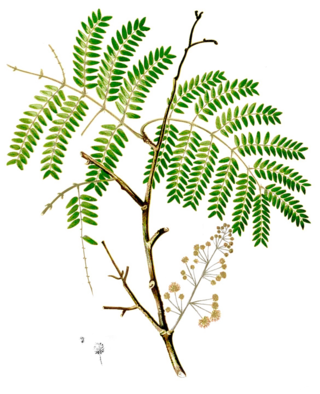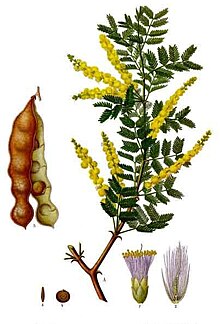
The Mimosoideae are a traditional subfamily of trees, herbs, lianas, and shrubs in the pea family (Fabaceae) that mostly grow in tropical and subtropical climates. They are typically characterized by having radially symmetric flowers, with petals that are twice divided (valvate) in bud and with numerous showy, prominent stamens.

Bauhinia is a large genus of flowering plants in the subfamily Cercidoideae and tribe Bauhinieae, in the large flowering plant family Fabaceae, with a pantropical distribution. The genus was named after the Bauhin brothers Gaspard and Johann, Swiss-French botanists.

Calliandra is a genus of flowering plants in the pea family, Fabaceae, in the mimosoid clade of the subfamily Caesalpinioideae. It contains about 140 species that are native to tropical and subtropical regions of the Americas.

Indigofera is a large genus of over 750 species of flowering plants belonging to the pea family Fabaceae. They are widely distributed throughout the tropical and subtropical regions of the world.

Senna, the sennas, is a large genus of flowering plants in the legume family. This diverse genus is native throughout the tropics, with a small number of species in temperate regions. The number of species is estimated to be from about 260 to 350. The type species for the genus is Senna alexandrina. About 50 species of Senna are known in cultivation.

Senegalia rugata is a spiny climbing shrub native to China and tropical Asia, common in the warm plains of central and south India. It is renowned as a raw material for shampoo, and the leaves and young shoots are often eaten. Archaeobotanical evidence shows its use for hair care in the pre-Harrapan levels of Banawali, some 4500–4300 years ago.

Chamaecrista is a genus of flowering plants in the pea family, Fabaceae, subfamily Caesalpinioideae. Members of the genus are commonly known as sensitive pea. Several species are capable of rapid plant movement. Unlike the related genera Cassia and Senna, members of Chamaecrista form root nodules.

Acaciella is a Neotropical genus of flowering plants in the legume family, Fabaceae, and its subfamily Mimosoideae. Its centre of diversity is along the Mexican Pacific coast. They are unarmed, have no extrafloral nectaries and the polyads of their pollen are 8-celled. Though its numerous free stamens is typical of Acacia s.l., it has several characteristics in common with genus Piptadenia. Its pollen and free amino acids resemble that of Senegalia. Molecular studies place it sister to a monophyletic clade comprising elements of genus Acacia, and the tribe Ingeae. A nectary ring is present between the stamens and ovary, in common with Acacia subg. Aculeiferum.

Mariosousa is a genus of 13 species of flowering plants in the family Fabaceae. It belongs to the mimosoid clade of the subfamily Caesalpinioideae. Members of this genus were formerly considered to belong to the genus Acacia.

Vachellia is a genus of flowering plants in the legume family, Fabaceae, commonly known as thorn trees or acacias. It belongs to the subfamily Mimosoideae. Its species were considered members of genus Acacia until 2009. Vachellia can be distinguished from other acacias by its capitate inflorescences and spinescent stipules. Before discovery of the New World, Europeans in the Mediterranean region were familiar with several species of Vachellia, which they knew as sources of medicine, and had names for them that they inherited from the Greeks and Romans.
Pityrocarpa is a genus of flowering plants in the family Fabaceae. It includes seven species of shrubs and small trees native to the tropical Americas, including western and southeastern Mexico, Guatemala and El Salvador, Venezuela and Guyana, Bolivia, and eastern Brazil. Native habitats include tropical coastal rain forest, gallery forest, secondary forest, woodland, wooded grassland (Cerrado), and thorn scrub (Caatinga). It belongs to the mimosoid clade of the subfamily Caesalpinioideae.
Senegalia thailandica is a species of climbing or sprawling shrub in the family Fabaceae.
Parasenegalia is a small genus of flowering plants in the legume family, Fabaceae. It belongs to the subfamily Mimosoideae. It is found in tropical areas of the Caribbean, Central America, and South America.
Senegalia megaladena is a spiny climber, shrub or tree, native to Jawa, and from mainland Southeast Asia to China and India. It is eaten as a vegetable and used as a fish poison. It is named after its distinctive large gland on the petioles.











